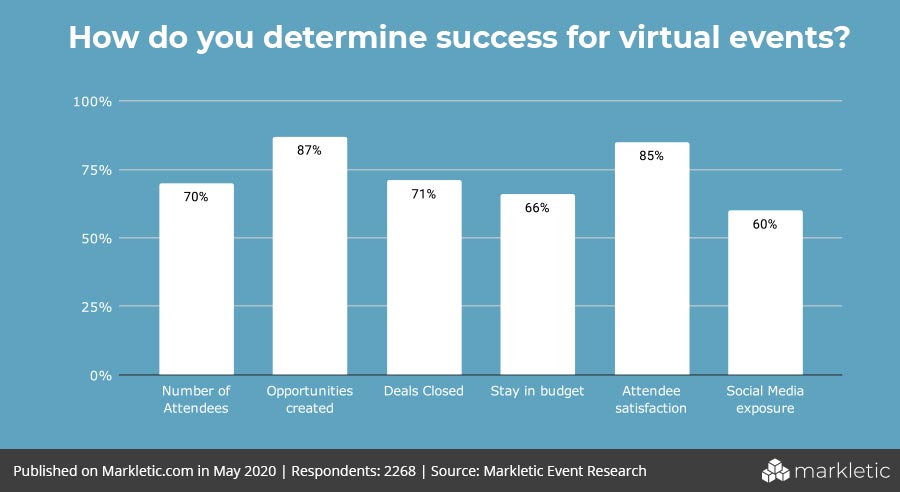10 Key Virtual Event KPIs to measure event success

Table of Contents
Virtual events play an integral role in today’s go-to-market model for many B2B companies. Marketers need to define virtual event KPIs to measure the performance of online events. In this article, we will focus on the top 10 metrics for event success.
What are virtual event KPIs?
Virtual event KPIs (Key Performance Indicators) are metrics that companies look at to measure the performance of a virtual event. Common KPIs include the number of registrations and opportunities created.
It’s important to determine the KPIs in the planning phase of a virtual event. This way you can agree with stakeholders such as sales and your management what needs to be achieved.
If you’re looking for more tips on perfecting your virtual event marketing plan, then take a look at this article of mine: 8 Tips to Perfect your Virtual Event Marketing Plan.
Typically, your virtual event KPIs are based on the expected return and the amount of money invested. It’s natural that for virtual events with a higher investment level, your company expects more return.
Virtual event KPIs must always be confirmed with a couple of stakeholders, namely:
- Marketing Management;
- Sales Management;
- Customer Success for customer-inclusive events.
It’s important that everyone is aligned on the KPIs of the virtual event. After all, post-event you need to assess whether it was worth the investment and if you should do it again.
Before diving in the details, let’s have a look at how B2B marketers determine virtual event success.

The virtual event KPIs listed below will cover the most important ones and some extras.

1. Deals closed as Virtual Event KPI
Every for-profit company is in business to make money. After all, without closing deals it’s going to be hard to pay the salaries of your employees.
That’s why 71% of event organizers rank deals closed as a success factor. (Markletic, 2020)
If every company wants to earn money, then why isn’t this 100 percent?
Well, some events have a different purpose. Some virtual events are hosted for goals such as:
- Improving the relationship with customers;
- Press events including journalist to boost awareness;
- Sales cycle acceleration.
Of course, most B2B companies either host virtual events or sponsor one for lead generation. That’s exactly why the vast majority of marketers say that deals closed is a key virtual event KPI.
It’s the easiest way to determine virtual event return on investment.
2. Opportunities created
A B2B purchase doesn’t happen in a week. B2B sales cycles are long and can take many months to complete.
That’s why 87% of marketers consider the opportunities generated by virtual events as a success factor. (Markletic, 2020)
Throughout the duration of a B2B sales cycle, many things can happen. There might be changes in your sales team, opportunities don’t get enough attention, or your sales aren’t able to develop a champion.
This means that a created opportunity might be lost. However, the lead generated could have been solid, and therefore it’s worth attending that event in the future.
Marketing is typically expected to contribute 30% to the sales pipeline. Opportunities that are lost are still pipeline generated.
That’s why B2B marketers consider opportunities created as a key virtual event KPI.
If you want to learn more about how much marketing should contribute to the sales pipeline, then read this article of mine.
3. Named Account Leads Generated
Many B2B companies have a go-to-market strategy based on named accounts. Named accounts are critical accounts that your sales team is focusing on.
Naturally, if your sales team has a focus on named accounts, then your marketing strategy should also be focused on named accounts.
Whether you host virtual events yourself or sponsor third-party virtual events, you need to be reporting on how many named account leads attended your virtual events.
When you acquire the contact details of named account leads, you are essentially opening doors for your sales team to do business with their named accounts.
This is critical and therefore named account leads generated are a key virtual event KPI.
A benefit of sponsoring virtual events is that it’s easier to schedule one-to-one meetings with named accounts. Check out these 6 benefits to sponsoring virtual events for more information.
4. Sales Pipeline acceleration
As mentioned, B2B sales cycles are complex. It will be very rare that a B2B purchasing decision is made by one person.
Generally, B2B purchases are made through buying teams. This means that multiple people will decide to purchase.
As you can imagine, an opportunity can be created when your sales have a good lead. But the more leads you generate from a certain account, the better.
That’s why sales pipeline acceleration is a key virtual event KPI. If your virtual events generate leads from accounts with an open opportunity, then you will open more doors for your sales team to accelerate that opportunity.
There might be true business pain at your prospect, but maybe the lead your sales is talking to is not the right person to move the sales cycle to the next stage.
If your virtual event generates top-quality leads, and it allows the sales cycle to move the next stage, then that is a clear success factor.
5. Attendee Retention
If you are hosting virtual conferences, then attendee retention is a virtual event KPI that you must measure.
Virtual conferences are generally quite long and can last many hours. The longer your audience is attending the conference, the better.
On the contrary, if 70% of the attendees drop-off after 30 minutes, then something is wrong.
So if you are hosting a virtual conference, then measure how long your audience is attending your event. It’s a good sign of the satisfaction level of your audience.
6. Audience Engagement
An engaged audience is worth a lot more than a distracted audience. Therefore, you must take measures to ensure that your audience is engaged throughout your virtual event.
The measures of engagement you take should be measurable. A common form of audience engagement in a virtual event is live polling.
An engaged audience will talk about your event; Both in-person and on social media.
Whatever you do to engage your audience, make sure you have tools in place to measure it so you can report it to management.
If you are looking for ways to engage your audience at virtual events, check out these 5 tips.
7. Audience Satisfaction
If you’re hosting your own virtual events, then of course you want your audience to be satisfied.
Attendee satisfaction is considered a success factor by 85% of marketers.
(Markletic, 2020)
A common way to measure audience satisfaction is through Net Promoter Scores.

Ideally, you want all of your audience to be promoters. Meaning they gave your virtual event of 9 or above.
This means that the audience will actively tell people about your virtual events. Why? Because they are satisfied with virtual events and you provided them with value.
Audience satisfaction is a key virtual event KPI that every event organizer must measure.
8. Sponsorship Revenue
If you are hosting large virtual conferences, then you’ll probably be selling sponsorship packages.
Sponsorship revenue is used the off-set the costs of the event or as a revenue model.
Before the event, you must agree with your management team on how much revenue you want to generate from sponsorships.
Here are some benefits to sponsoring virtual events.
9. Number of Registrations
When you are hosting a virtual event, then an early indicator of event success is the number of registrations you are obtaining.
If the number of registrations are not at a satisfactory level, then you can adjust your virtual event promotion campaign to get more registrations.
It’s also important to have strategies in place to ensure that the people that have registered for your virtual event will actually join.
The average no-show percentage of virtual events is 35%.(Markletic, 2020)
Here are some strategies that I use to promote virtual events.
10. Cost per MQL
A critical virtual event KPI is the cost per MQL. As a company, you will spend more to generate MQLs.
If you take all of your marketing expenses combined, you can calculate the average cost per MQL for your business.
For example, let’s say that the average cost per MQL for your company is $100.
If your virtual event has an average cost per MQL of $80, then you are doing something right.
It must be noted that cost per MQL metric requires some extra attention.
At B2B companies, you are marketing to multiple personas.
For simplicity’s sake, let’s say you are marketing to decision-makers and influencers.
You must look at the average cost per MQL for each persona (decision-maker or influencer).
If the average cost per MQL of your company is $100, and your virtual event is focused on decision-makers. If the average cost per MQL of your virtual event is $110, it doesn’t mean that it is a bad performance.
Your company's average cost per MQL for decision-makers is probably higher than $110, so in this case, your virtual event would be performing very well.
Therefore, the average cost per MQL is a key virtual event KPI that requires proper analysis.
Virtual Event Dashboard
So, now you know what virtual event KPIs are important for your business. The next step is to have an easy way to access this data and to report on it.
After all, you will need to show this data to stakeholders such as sales and your management team.
For B2B events, I always recommend creating a dashboard on your CRM. Most B2B companies use Salesforce. Check out this guide that I wrote on how to create the ideal B2B event dashboard.
Share this article



